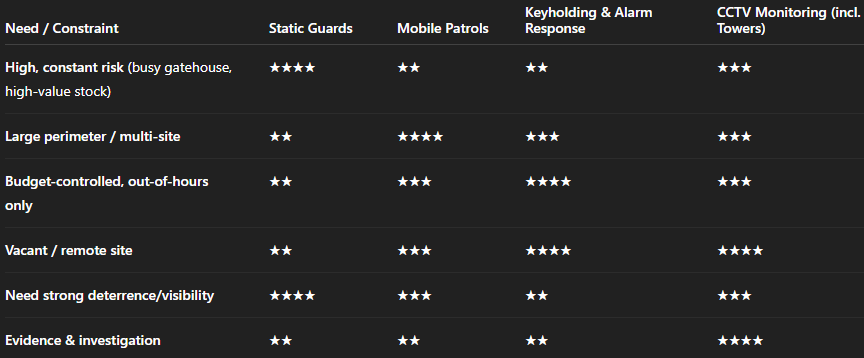The UK Business Security Playbook 2025: From SIA Compliance to 24/7 Response
A practical, up-to-date security guide for UK facilities and operations leaders. This playbook explains what’s changed in 2025, how to stay SIA-compliant, how to choose between static guards, mobile patrols, keyholding, and CCTV monitoring, and how to build an incident-ready alarm response workflow. It includes checklists, a quick decision matrix, and templates you can adapt for your site.
1) What’s new in 2025 (and why it matters)
Security risk is shifting on three fronts:
- Opportunistic crime + organised theft: retail, logistics, and light industrial sites remain prime targets—especially out of hours and during staff changeovers.
- Vacant & low-occupancy risk: unstaffed units invite trespass, theft, arson, and liability issues without a visible security presence or remote monitoring.
- Compliance scrutiny: buyers (and insurers) increasingly ask for SIA-licensed personnel, auditable alarm response workflows, and data-savvy CCTV governance.
Bottom line: Documented, auditable security combined with rapid out-of-hours response is no longer “nice to have”—it’s table stakes.
2) SIA compliance: quick self-audit (5 checks)
Use this 5-minute pulse check to avoid costly gaps:
- Licences verified — All guarding, door supervision, CCTV public-space monitoring, and keyholding staff are SIA-licensed and in date.
- Right role, right badge — Roles match licences (e.g., CCTV monitoring vs. static guarding).
- ID & onboarding — Vetting, site inductions, and assignment instructions are recorded and accessible.
- Reporting trail — Incidents, patrols, and callouts are logged with timestamps and actions taken.
- Contractor governance — If you outsource, keep copies of SIA approvals, insurance, and service KPIs.
If any “No,” fix before an audit—or before an incident forces the issue.
3) Choosing the right protection: quick decision matrix
Match your risk profile to the most effective (and cost-sensible) model.

How to combine:
- Pair Keyholding + Alarm Response with Mobile Patrols for budget-efficient deterrence + rapid incidents cover.
- Add CCTV Monitoring (or Mobile CCTV Towers) for remote/after-hours eyes and evidence.
- Use Static Guards where constant control, screening, or concierge/security presence is essential.
4) Build a 24/7 alarm response workflow (copy & adapt)
Goal: No night-time guesswork, no unsafe staff callouts, no insurer disputes.
- Detection — Intrusion alarm / video analytics triggers.
- Verification — Monitoring confirms likely incident (camera view, multiple sensor trips).
- Dispatch — Licensed keyholding responder attends with secure access; police/fire informed per URN/policy.
- On-site actions — Scene made safe, building re-secured, emergency board-up if needed.
- Report & escalate — Incident log with timestamps, media, actions; landlord/insurer notified as required.
- Remediation — Temporary measures (extra patrols, tower deployment); root-cause fix (locks, lighting, procedures).
Tip: Make the responder—not your on-call manager—the first attendance at 3am. It’s safer and faster.
5) Event security & crowd plans (if applicable)
For corporate events, retail peaks, or on-site activations:
- Risk assessment (site specifics, VIPs, capacity, egress).
- Access control & screening (search policy, prohibited items).
- Zoning & comms (radio channels, escalation tree).
- Emergency protocols (medical, evacuation, lockdown).
- Post-event debrief (incidents, improvements, lessons learned).
6) Vacant property playbook (reduce burn, theft, liability)
- Secure & board vulnerable points; document condition with time-stamped photos.
- Deterrence cadence: randomised mobile patrols > predictable rounds.
- Remote eyes: mobile CCTV towers with IR + audio challenge; cellular uplink.
- Inspections: leak checks, fly-tipping, evidence of entry; keep insurer-friendly logs.
- Escalation: fast board-up and increased patrols after any attempt.
7) Documentation bundle (templates you can adapt today)
- Security Policy (roles, licencing, access control, visitor policy).
- Alarm Response SOP (who, how, when; comms; report format).
- Guard Post Orders (site-specific duties, patrol routes, key assets).
- Incident Report Form (timeline, actions, evidence checklist).
- Visitor & Contractor Register (ID, permit-to-work if relevant).
Tip: Store in a shared location, print a “grab sheet” at reception/gatehouse, and train quarterly.
8) Procurement checklist (buy once, buy right)
- Licences & insurance verified (SIA, public liability, employer’s liability).
- KPIs agreed (response times, reporting SLA, patrol frequency, evidence turnaround).
- Supervision & escalation (duty manager 24/7, named contract lead).
- Data governance (CCTV retention, subject access procedures, signage).
- Continuity (surge capacity, sickness/holiday cover, disaster plan).
9) 90-day improvement plan (fast wins)
Weeks 1–2: Licence audit; alarm URNs confirmed; contact trees updated; signage fixed.
Weeks 3–4: Patrol routes optimised; lighting survey (replace failed lamps, add PIRs); camera viewpoints adjusted.
Weeks 5–8: Keyholding contract finalised; alarm SOP trained and drilled; incident forms standardised.
Weeks 9–12: Add mobile CCTV to blind spots; review false alarm reduction; management review of KPIs and next quarter plan.
How Force8 can help (and where to start)
- Keyholding & Alarm Response (24/7) — Safer, faster out-of-hours attendance.
- Mobile Patrols & Static Guards — Visible deterrence and on-site control.
- CCTV Monitoring & Mobile CCTV Towers — Remote eyes, evidence, audio challenge.
- Vacant Property Inspections — Insurance-friendly logs, board-up, and rapid remediation.
Next step: Book a free Security Readiness Review. We’ll map your current posture, confirm compliance, and propose a right-sized plan for your site.

